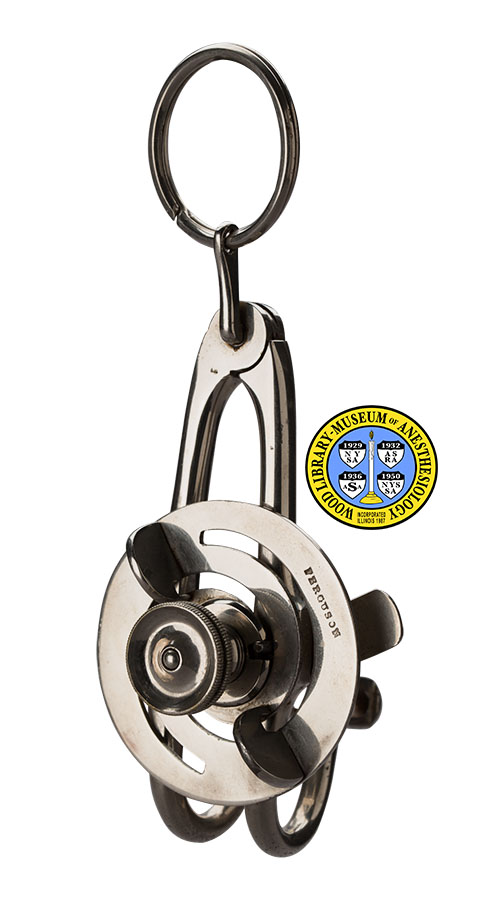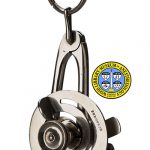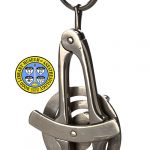Gowan Cleft Palate Gag
Mouth gags are devices used to hold the patient’s mouth open. They have been used for dentistry, oral surgery and anesthesia. In 1884, British physician and inventor B. Campbell Gowan introduced both his mouth gag and a tongue depressor intended for use with the gag in cleft palate surgery.
Each of the long arms or “blades” of the gag ends in a D-shaped curve, with an extension called a “tooth plate”. The tooth-plates were originally cushioned with rubber. These were inserted between the patient’s upper and lower jaws. The disc on the opposite side of the blades (facing the operator) was controlled by finger-holds. These were used to rotate the disc either forward, toward the patient, or back toward the operator. Turning it forward pushed the two blades apart, opening the patient’s mouth. Turning the disc back brought the blades together. By unscrewing the knob on top of the disc, the gag could be completely disassembled for cleaning.
The gag appeared in several manufacturers’ catalogs and other publications through the early years of the 20th Century. This example was made by the London surgical equipment manufacturer, Ferguson; some decades earlier, the same company had also made the Snow Inhaler.
Catalog Record: Gowan Cleft Palate Gag
Access Key: amya
Accession No.: 2010-09-23-7 F]
Title: [Gowan mouth gag] / [designed by B. Campbell Gowan].
Author: Gowan, B. Campbell.
Title variation: Alt Title
Title: Gowan’s cleft palate mouth gag.
Title variation: Alt Title
Title: Gowan’s eccentric mouth gag.
Publisher: [London, England] : Ferguson, [between 1884 and 1920].
Physical Descript: 1 mouth gag : metal ; 6 x 7 x 13.5 cm.
Note Type: General
Notes: The first year in the date range is the year of introduction; the second year
in the date range is the start of the decade following the latest known
published reference. The company was known to have had several variant names
(e.g. Daniet Ferguson, Ferguson & Son) from 1822 to 1870. No references to
the company have been found after 1870.
In the original description of the gag (Lancet, 1884), the inventor was
called “Mr. B. Campbell Gowan, of Guy’s Hospital”. In the 2nd edition of his
anesthesia textbook, Dudley W. Buxton called him “my friend Mr. Gowan”.
Several other inventions are credited to him in the British Medical Journal’s
description of equipment exhibited by the London instrument maker, Down
Brothers, in 1885 and 1886. In 1894, the Lancet printed his letter to the
editor. The cataloger found no other biographical information about him. The
fact that he was known as “Mr.” rather than “Dr.” suggests that he might have
been a surgeon.
Note Type: Citation
Notes: Catalogue of Surgical Instruments and Appliances Manufactured by Arnold &
Sons. London: Arnold & Sons; 1895.
Note Type: Citation
Notes: Fifty-third annual meeting of the British Medical Association: the annual
museum. BMJ. September 5, 1885;2(1288):449.
Note Type: Citation
Notes: Fifty-fourth annual meeting of the British Medical Association: annual museum
BMJ. September 4, 1886;2(1340):458.
Note Type: Citation
Notes: Buxton DW. Anaesthetics: Their Uses and Administration. 2nd ed.
Philadelphia: P. Blakiston’s Son & Co.; 1892:48.
Note Type: Citation
Notes: Wholesale Catalogue of Surgical Instruments and Appliances. London: Down
Brothers, Ltd.; 1906.
Note Type: Citation
Notes: Gowan BC. The Cavendish lecture. Lancet. September 8, 1894;144(3706):597.
Note Type: Citation
Notes: A new gag and tongue depressor. Lancet. April 19, 1884;123(3164):713.
Note Type: Citation
Notes: A Catalogue of Surgical Instruments and Hospital Requirements Manufactured
and Sold by Mayer & Meltzer. London: Mayer & Meltzer; 1899.
Note Type: Citation
Notes: Illustrated Catalogue of Surgical Instruments, Appliances and Cutlery,
Manufactured and Sold by J. H. Montague. London: J. H. Montague; 1897.
Note Type: Physical Description
Notes: This description is given from the point of view of the patient; Height
equates to the length of the connecting bar; Width has been measured from the
forward tip of the “tooth plates” to the top of the screw; Depth has been
measured with the ring extended in a straight line toward the operator;
The gag has two arms or “blades”, each with a sharp curve at that end which
is inserted in the mouth; One of these blades is stamped with the letter “L”
on inner side (that facing the patient); The curve of each blade ends in a
forward extension (called by the inventor a “tooth plate”) that, when in use,
would be seated against the upper or lower jaw; Each of these plates was
originally cushioned by a rubber tube; At the opposite end, nearest the
operator, the blades are held together by a rivet, and are shaped to allow
smooth motion around the rivet; The same rivet holds a short, swiveling post;
The post holds an empty key ring (the cataloger found no published
explanation of the ring);
The inner side of each blade features a small protruding pin; On the same
side, and positioned behind the curved portion of the blades, a flat, curved
bar is fitted into a curved slot on the inner side of each blade; As the disc
is turned, these slots allow the blades to move in tandem along this bar; A
screw connects the bar to the components on the outer side of the blades
(facing the operator); These components consist of a slotted washer, a
slotted disc and a knob;
The washer has two small, equidistant slots in its rim, into which the pins
on the inner side of the blades fit when the blades are positioned together;
The disc is pierced by two curved slots that form a spiral; On the inner side
the disc is stamped “FERGUSON”; On the outer side of the disc there are two
equidistant, upright flanges that can be manipulated by finger and thumb to
rotate the disc toward the front or the back of the gag; Rotating the disc in
the forward direction exerts pressure on the blades, pushing them apart and
causing the disc to rise slightly; Turning the disc backward (toward the
operator) pulls the blades closer together;
The pin on the back of each blade fits into one of the slots in the disc;
When the end of each slot meets a pin, the disc cannot be turned any further
in that direction;
The knob can be tightened on the screw to hold these components in place, or
removed completely so that the parts can be disassembled and cleaned.
Note Type: Reproduction
Notes: Photographed by Mr. Steve Donisch, January 11, 2016.
Note Type: Historical
Notes: Mouth gags are devices used to hold the patient’s mouth open. They have been
used for dentistry, oral surgery and anesthesia. In 1884, British physician
and inventor B. Campbell Gowan introduced both his mouth gag and a tongue
depressor intended for use with the gag in cleft palate surgery.
Each of the long arms or “blades” of the gag ends in a D-shaped curve, with
an extension called a “tooth plate”. The tooth-plates were originally
cushioned with rubber. These were inserted between the patient’s upper and
lower jaws. The disc on the opposite side of the blades (facing the
operator) was controlled by finger-holds. These were used to turn the disc
either forward, toward the patient, or back toward the operator. Turning the
disc forward pushed the two blades apart, opening the patient’s mouth.
Turning it back brought the blades together. By loosening the knob on top of
the disc, the gag could be completely disassembled for cleaning.
The gag appeared in several manufacturers’ catalogs and other publications
through the early years of the 20th Century. This example was made by the
London surgical equipment manufacturer, Ferguson; the same company made the
Snow Inhaler.
Note Type: Exhibition
Notes: Selected for the WLM website (noted January 4, 2016).



